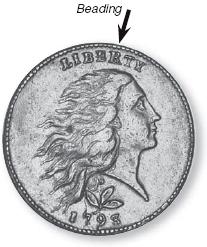
Glossary of Coin Terms
Adjustment marks: Marks made by use of a file to correct the weight of overweight coinage planchets prior to striking. Adjusting the weight of planchets was a common practice at the first U.S. Mint in Philadelphia and was often carried out by women hired to weigh planchets and do any necessary filing of the metal.
Altered coin: A coin that has been changed after it left the mint. Such changes are often to the date or mintmark of a common coin in an attempt to increase its value by passing to an unsuspecting buyer as a rare date or mint.
Alloy: A metal or mixture of metals added to the primary metal in the coinage composition, often as a means of facilitating hardness during striking. For example, most U.S. silver coins contain an alloy of 10 percent copper.
Anneal: To heat in order to soften. In the minting process planchets are annealed prior to striking.
Authentication: The act of determining whether a coin, medal, token or other related item is a genuine product of the issuing authority.
Bag marks: Scrapes and impairments to a coin’s surface obtained after minting by contact with other coins. The term originates from the storage of coins in bags, but such marks can occur as coins leave the presses and enter hoppers. A larger coin is more susceptible to marks, which affect its grade and, therefore, its value.
Base metal: A metal with low intrinsic value.
Beading: A form of design around the edge of a coin. Beading once served a functional purpose of deterring clipping or shaving parts of the metal by those looking to make a profit and then return the debased coin to circulation.

Blank: Often used in reference to the coinage planchet or disc of metal from which the actual coin is struck. Planchets or blanks are punched out of a sheet of metal by what is known as a blanking press.
Business strike: A coin produced for circulation.
Cast copy: A copy of a coin or medal made by a casting process in which molds are used to produce the finished product. Casting imparts a different surface texture to the finished product than striking and often leaves traces of a seam where the molds came together.
Center dot: A raised dot at the center of a coin caused by use of a compass to aid the engraver in the circular positioning of die devices, such as stars, letters, and dates. Center dots are prevalent on early U.S. coinage.
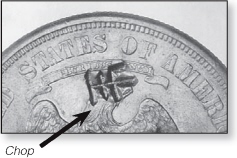
Chop: A mark used by Oriental merchants as a means of guaranteeing the silver content of coins paid out. The merchants’ chop, or stamped insignia, often obliterated the original design of the host coin. U.S. Trade dollars, struck from 1873 through 1878 and intended for use in trade with China, are sometimes found bearing multiple marks.
Clash marks: Marks impressed in the coinage dies when they come together without a planchet between them. Such marks will affect coins struck subsequently by causing portions of the obverse design to appear in raised form on the reverse, and vice versa.
Clipping: The practice of shaving or cutting small pieces of metal from a coin in circulation. Clipping was prevalent in Colonial times as a means of surreptitiously extracting precious metal from a coin before placing it back into circulation. The introduction of beading and a raised border helped to alleviate the problem.
Coin alignment: U.S. coins are normally struck with an alignment by which, when a coin is held by the top and bottom edge and rotated from side-to-side, the reverse will appear upside down.
Collar: A ring-shaped die between which the obverse and reverse coinage dies are held during striking. The collar contains the outward flow during striking and can be used to produce edge reeding.
Commemorative: A coin issued to honor a special event or person. United States commemorative coins have historically been produced for sale to collectors and not placed in circulation, though the 50-states quarters are circulating commemoratives.
Copy: A replica of an original issue. Copies often vary in quality and metallic composition from the original. Since passage of the Hobby Protection Act (Public Law 93-167) of Nov. 29, 1973, it has been illegal to produce or import copies of coins or other numismatic items that are not clearly and permanently marked with the word “Copy.”
Counterfeit: A coin or medal or other numismatic item made fraudulently, either for entry into circulation or sale to collectors.
Denticles: The toothlike pattern found around a coin’s obverse or reverse border.
Die: A cylindrical piece of metal containing an incuse image that imparts a raised image when stamped into a planchet.
Die crack: A crack that develops in a coinage die after extensive usage, or if the die is defective or is used to strike harder metals. Die cracks, which often run through border lettering, appear as raised lines on the finished coin.
Device: The principal design element.
Double eagle: Name adopted by the Act of March 3, 1849, for the gold coin valued at 20 units or $20.
Eagle: Name adopted by the Coinage Act of 1792 for a gold coin valued at 10 units or $10. Also a name used to refer to gold, silver, and platinum coins of the American Eagle bullion coinage program begun in 1986.
Edge: The cylindrical surface of a coin between the two sides. The edge can be plain, reeded, ornamented, or lettered.
Electrotype: A copy of a coin, medal, or token made by electroplating.
Exergue: The lower segment of a coin, below the main design, generally separated by a line and often containing the date, designer initials, and mintmark.
Face value: The nominal legal-tender value assigned to a given coin by the governing authority.
Fasces: A Roman symbol of authority consisting of a bound bundle of rods and an axe.
Field: The flat area of a coin’s obverse or reverse, devoid of devices or inscriptions.
Galvano: A reproduction of a proposed design from an artist’s original model produced in plaster or other substance and then electroplated with metal. The galvano is then used in a reducing lathe to make a die or hub.
Glory: A heraldic term for stars, rays or other devices placed as if in the sky or luminous.
Grading: The largely subjective practice of providing a numerical or adjectival ranking of the condition of a coin, token, or medal. The grade is often a major determinant of value.
Gresham’s law: The name for the observation made by Sir Thomas Gresham, 16th century English financier, that when two coins with the same face value but different intrinsic values are in circulation at the same time, the one with the lesser intrinsic value will remain in circulation while the other is hoarded.
Half eagle: Name adopted by the Coinage Act of 1792 for a gold coin valued at five units or $5.
Hub: A piece of die steel showing the coinage devices in relief. The hub is used to produce a die that, in contrast, has the relief details incuse. The die is then used to produce the final coin, which looks much the same as the hub. Hubs may be reused to make new dies.
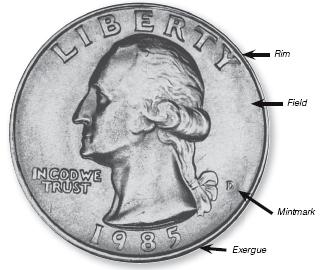
Obverse
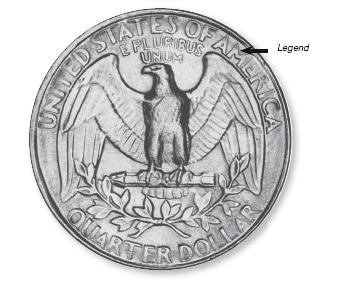
Reverse
Legend: A coin’s principal lettering, generally shown along its outer perimeter.
Lettered edge: Incuse or raised lettering on a coin’s edge.
Matte proof: A proof coin on which the surface is granular or dull. On U.S. coins this type of surface was used on proofs of the early 20th century. The process has since been abandoned.
Magician’s coin: A term sometimes used to describe a coin with two heads or two tails. Such a coin is considered impossible in normal production due to physical differences in obverse and reverse die mountings, though as of 2001 two have been certified as genuine by professional coin authenticators. The vast majority are products made outside the Mint as novelty pieces.
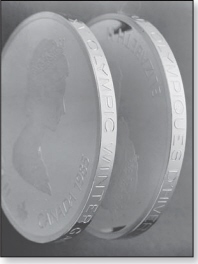
These Canadian Olympic commemoratives have lettered edges.
Medal: Made to commemorate an event or person. Medals differ from coins in that a medal is not legal tender and, in general, is not produced with the intent of circulating as money.
Medal alignment: Medals are generally struck with the coinage dies facing the same direction during striking. When held by the top and bottom edge and rotated from side-to-side, a piece struck in this manner will show both the obverse and reverse right side up.
Mintage: The total number of coins struck during a given time frame, generally one year.
Mintmark: A letter or other marking on a coin’s surface to identify the mint at which the coin was struck.
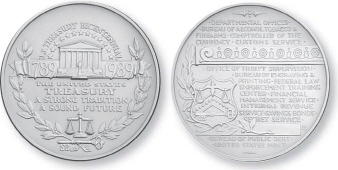
A medal usually commemorates an event but has no monetary value. It can be issued by a private entity or a government.
Mule: The combination of two coinage dies not intended for use together.
Numismatics: The science, study or collecting of coins, tokens, medals, paper money, and related items.
Obverse: The front or “heads” side of a coin, medal, or token.
Overdate: Variety produced when one or more digits of the date are repunched over an old date on a die at the Mint, generally to save on dies or correct an error. Portions of the old date can still be seen under the new one.
Overmintmark: Variety created at the Mint when a different mintmark is punched over an already existing mintmark, generally done to make a coinage die already punched for one mint usable at another. Portions of the old mintmark can still be seen under the new one.
Overstrike: A coin, token or medal struck over another coin, token, or medal.
Pattern: A trial strike of a proposed coin design, issued by the Mint or authorized agent of a governing authority. Patterns can be in a variety of metals, thicknesses, and sizes.
Phrygian cap: A close-fitting, egg-shell-shaped hat placed on the head of a freed slave when Rome was in its ascendancy. Hung from a pole, it was a popular symbol of freedom during the French Revolution and in 18th century United States.
Planchet: A disc of metal or other material on which the image of the dies are impressed, resulting in a finished coin. Also sometimes called a blank.
Proof: A coin struck twice or more from specially polished dies and polished planchets. Modern proofs are prepared with a mirror finish. Early 20th century proofs were prepared with a matte surface.
Prooflike: A prooflike coin exhibits some of the characteristics of a proof despite having been struck by regular production processes. Many Morgan dollars are found with prooflike surfaces. The field will have a mirror background similar to that of a proof, and design details are frosted like some proofs.
Quarter eagle: Name adopted by the Coinage Act of 1792 for a gold coin valued at 2.5 units or $2.50.
Reeding: Serrated (toothlike) ornamentation applied to the coin’s edge during striking.
Relief: The portion of a design raised above the surface of a coin, medal, or token.
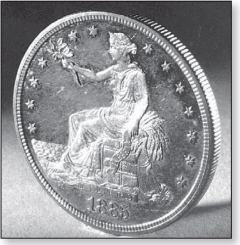
This U.S. Trade dollar has a reeded edge.
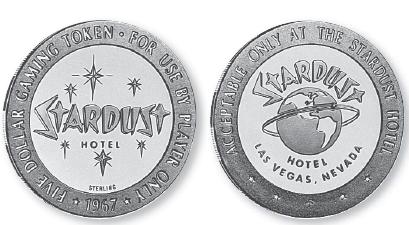
A token is issued by a private entity and can be redeemed for its face value in trade or service.
Restrike: A coin, medal or token produced from original dies at a later date, often with the purpose of sale to collectors.
Reverse: The backside or “tails” side of a coin, medal or token, opposite from the principal figure of the design or obverse.
Rim: The raised area bordering the edge and surrounding the field.
Series: The complete group of coins of the same denomination and design and representing all issuing mints.
Token: A privately issued piece, generally in metal, with a represented value in trade or offer of service. Tokens are also produced for advertising purposes.
Type coin: A coin from a given series representing the basic design. A type coin is collected as an example of a particular design rather than for its date and mintmark.
Variety: Any coin noticeably different in dies from another of the same design, date and mint. Overdate and overmintmarks are examples of varieties.
Wire edge: Created when coinage metal flows between the coinage die and collar, producing a thin flange of coin metal at the outside edge or edges of a coin.